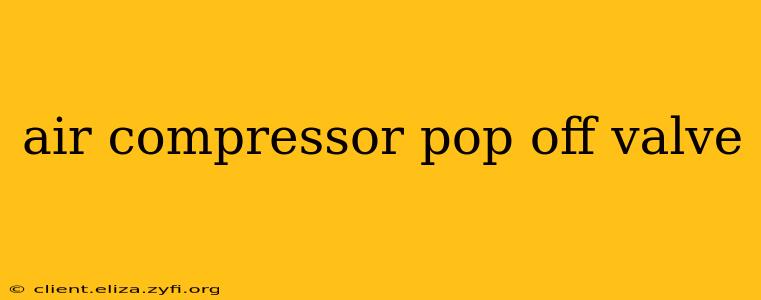An air compressor pop-off valve, also known as a pressure relief valve or safety valve, is a critical safety component. It's designed to automatically release compressed air when the tank pressure exceeds a predetermined safe limit, preventing potentially dangerous overpressurization. Understanding how this valve works, troubleshooting issues, and performing regular maintenance are crucial for safe and efficient air compressor operation.
What is the Purpose of an Air Compressor Pop-Off Valve?
The primary purpose of the pop-off valve is safety. Without it, the tank could burst under excessive pressure, leading to serious injury or property damage. The valve acts as a fail-safe mechanism, releasing excess air when the pressure surpasses the maximum safe operating pressure (MSOP) stamped on the tank. This MSOP is usually clearly visible on the tank itself. The valve opens automatically at this pressure, releasing air until the pressure drops below the set point. Then, it automatically closes.
How Does an Air Compressor Pop-Off Valve Work?
Most pop-off valves operate using a spring-loaded mechanism. A spring holds a weighted valve closed against the compressed air pressure inside the tank. Once the pressure exceeds the spring's tension, the valve lifts, allowing the air to escape. The valve is designed to reseat when the pressure drops below the set point, stopping the air release. Some valves might incorporate a small orifice or a weighted disc instead of a spring for pressure regulation.
Why is My Air Compressor Pop-Off Valve Leaking?
A leaking pop-off valve can indicate several issues. It's crucial to address these promptly to maintain safe operation. Here are some common causes:
-
Excessive Pressure: If the pressure consistently reaches the pop-off valve's limit, there might be a problem with the pressure switch or unloader valve, causing the compressor to run longer than necessary. This could indicate a need for maintenance or repair of these components.
-
Valve Wear and Tear: Over time, the valve's internal components can wear out, leading to leakage. The spring might lose its tension, or the valve seat might become damaged, allowing air to escape even at normal operating pressures. Regular inspection is essential to catch this early.
-
Dirt and Debris: Dirt or debris can clog the valve, preventing it from sealing properly. This could occur if the air intake is not properly filtered.
-
Damaged Valve: Physical damage to the valve itself, caused by impact or corrosion, could also lead to leakage.
How to Test an Air Compressor Pop-Off Valve?
Testing your pop-off valve is a simple safety check that should be part of your regular air compressor maintenance. However, always disconnect the power to the air compressor before performing any maintenance or testing.
You can generally test it by observing the pressure gauge. If it consistently reaches the pressure indicated on the pop-off valve or the tank's MSOP, and you hear or see air releasing, the valve is likely functioning correctly. However, if the pressure continues to rise beyond the MSOP, the valve could be faulty and needs immediate replacement. Do not attempt to manually force the valve open.
How Often Should I Check My Air Compressor Pop-Off Valve?
You should visually inspect your pop-off valve at least once a month and more frequently if your compressor is used heavily. Look for any signs of damage, corrosion, or leakage. Perform a pressure test as described above as part of this regular inspection.
What Happens If My Air Compressor Pop-Off Valve Fails?
A failed pop-off valve is a serious safety hazard. If it doesn't release pressure when needed, the tank could over-pressurize, potentially leading to a catastrophic rupture. This could result in serious injury or property damage. Always replace a faulty pop-off valve immediately. Never attempt to repair it yourself.
Can I Replace My Air Compressor Pop-Off Valve Myself?
Replacing a pop-off valve is a relatively straightforward task for those with basic mechanical skills. However, if you are uncomfortable working with pressurized systems, it's best to consult a qualified technician. Refer to your air compressor's owner's manual for specific instructions. Remember to always disconnect the power before attempting any repairs. Safety should always be the top priority.
This information is for general guidance only. Always refer to your air compressor's owner's manual for specific instructions and safety precautions. Remember that safety is paramount when working with compressed air systems.
